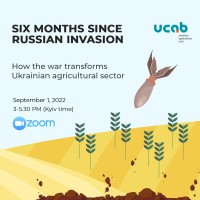Новини
05.09.2022
Six months since russian invasion: How the war transforms Ukrainian agricultural sector

Ukrainian Agribusiness Club together with UCABevent agency organized the online event “Six months since russian invasion: How the war transforms Ukrainian agricultural sector” on the first of September during which speakers shared their thoughts about main changes and challenges that have occurred in the agricultural sector.
Key speakers:
- Dr. Hubertus Gay, OBCE Paris;
- Dr. Alex Lissitsa, CEO of IMC (ag company);
- Denys Bashlyk, Deputy Minister of Agrarian Policy and Food of Ukraine;
- Professor Dr. Alfons Balmann, IAMO;
- Kateryna Rybachenko, Vice-President of UCAB and Member of Supervisory board of Agro Region;
- Georg von Nolcken, CEO of Continental Farmers Group.
We offer to get acquainted with the main messages of the event:
- Russia’s aggression against Ukraine and political responses have significant and potentially longer-lasting implications for producers and consumers. Reduced cereals and oilseeds export availability from Ukraine is pushing up international food and feed prices. Moreover, global energy and fertilizer prices have increased from their already high levels due to russia’s aggression and the resulting uncertainty related to the availability of russian energy and fertilizer globally. As the agri-food sector is highly-energy intensive, rising energy and fertilizer prices are translating into higher production costs and contributing to food price increases.
- Although market balances suggest globally sufficient supplies of wheat and other monitored commodities, markets remain tight. Moreover, adjustments in trade flows and rising energy costs are leading to increases in international agricultural commodity prices. In March 2022, the FAO Food Price Index (FFPI) reached its highest level on record since 1990, at 159.7 points. The FFPI retreated slightly in April and May 2022, though still 30% above its value in the corresponding months in the previous year. Price increases have been particularly significant for vegetable oils and cereals. Vulnerable populations in Low-Income Food-Deficit Countries, who spend a large share of their income on food, are particularly exposed to these price hikes.
- Indirect losses to Ukrainian agriculture due to production decrease, higher production costs, logistics disruption and lower prices for export-oriented commodities have been estimated at USD 23.3 billion.
- During the first three months of the war the Ministry of Agrarian Policy and Food of Ukraine was firefighting and tackling new problems. Currently, the ministry is trying to make some midterm planning for the work of the agricultural sector during the war, and also to plan for the future for rebuilding and how the agricultural sector should be developed after the war.
- The successful 2020 and 2021 seasons had helped farmers immensely to build cashflow and liquidity reserves, but they are quickly running out. The longer the situation with unstable exports continues, the longer Ukrainian agriculture will convert into a survival game, which is driven by cashflow. Now all participants in the agricultural sector are thinking about how Ukraine can reach a level where the damage to Ukrainian agriculture will be bearable for the world.
- For six months, Ukrainian exports have changed dramatically. Since sea ports were blocked, in order to transport agricultural products, which is equivalent to one Panamax ship (60,000 t), it was necessary 932 ukrainian wagons (1 wagon = 65 t) or 17 trains (1 freight train consists of 54 wagons). But European Railway has other indicators: 1 wagon = 55 t, 1 freight train consists of 32 wagons, total weight of the wagons 55*32 = 1,760 t. So, there is a need for 1875 wagons or 34 trains. It means the EU needs twice as many trains and locomotives to transport Ukrainian wheat. And it affects the time and cost of logistics. Before the opening of the blocked ports of Odessa, Ukraine exported roughly 2 million tons of grains and oil seeds, most of them by railway and cars. Odesa seaports were opened only at the end of July and in a month Ukraine was able to increase its cargo turnover to 4.6 million tons of various types of agricultural products. Thus, Ukraine will be able to increase exports several times in the coming months, if this agreement continues to work.
- In 2021, the main problem for farmers was the land market, but now the biggest challenge is logistic export low liquidity and a lot of other challenges like lack of storage facilities, lack of human capital, lack of natural gas, minefields in many regions, increasing input prices, no banking finance, mobilisation and etc.
“The war in Ukraine has shown that many people don't fully understand what exactly means their food security and what is the importance of the global food chain. . But now the top priority of global institutions is to consider how to improve food security by planning global world politics, taking into account Ukraine's place in it”, – stated Alex Lissitsa.
If we talk about the role of Ukraine in the growth of prices in the global market, then Dr. Hubertus Gay mentioned: “In 2021/22 MY crop production in Ukraine increased for most crops and there was a record harvest. But due to the export constraints over the whole season, not everything that could be exported was exported. And when we look at the effect on prices, one of the reasons was that actually the cost of freight rates was increasing. The freight transport was not always working fine and there were bottlenecks that actually increased the price.
The price will turn down to another level. But in the short term structurally, large changes in trade flows have actually pushed up prices and it's still ongoing. We don't know how long that effect will last.
For the current harvest, a decline is expected and exports will be hit even more, which will have a “substantial impact” on global availability of grain in the coming season”.
Georg von Nolcken draws attention to such features of the 2022 harvest and its storage: “Most crops give good harvests throughout Ukraine. But the irony is that it exacerbates our problems, because part of the storage we planned for the sunflowers, the maize and the soya in the second wave of harvest is now completely blocked with the first wave of crops”.
In addition to the problems of the new crop Alex Lissitsa added: “Last year farmers enjoyed an excellent maize harvest, making more than US $1,000/ha (£865/ha), but this year we have a “big minus”. For many companies it doesn’t make sense even to start harvesting corn with the price of $2,000 for 1,000 cu. m of natural gas”.
“It’s very unexpected for agrarians that, depending on the region of Ukraine, problems change. Our business is used to working on some typical scheme but now we have many force majeure obstacles that are specific to every region. For example, for the regions where the war is currently ongoing, there is a huge problem of mine fields.
Now it all depends on you, - if you can buy fertilizers and seeds, at what cost, how much money you will bring to your farm, how much money you would have to buy fuel on market price and so how much money you need it depends on where you are.
The further you're from the market, the less chance that the planting season of autumn and spring crops is going to be completed, and the chances of potentially spring seeding are decreasing from west towards the east”, – stressed Kateryna Rybachenko.
There are also changes in agribusiness in terms of communication with government agencies. According to the words of Denys Bashlyk, “until February 24-th the main request from agribusiness was do not disturb, not intervene from the government side. Right now the main message is – we need your support, we need support from the government in many spheres. And we found a lot of international opportunities, unfortunately, for a very high price of war”.
So finally Dr. Alfons Balmann predicted that “in the future those companies which are efficient, which are able to pay adequate salaries may be able to attract people to come back to Ukraine as long as they also can provide attractive living conditions in agricultural settlements.
Modernization of agriculture was already on a good track before the war and it still has huge potential to be competitive on the global market. But on the other hand, the agriculture sector have to contribute more money to development and to provision of agro infrastructures and that will be a new revived agrosphere in rebuilded Ukraine”.





































































































































































